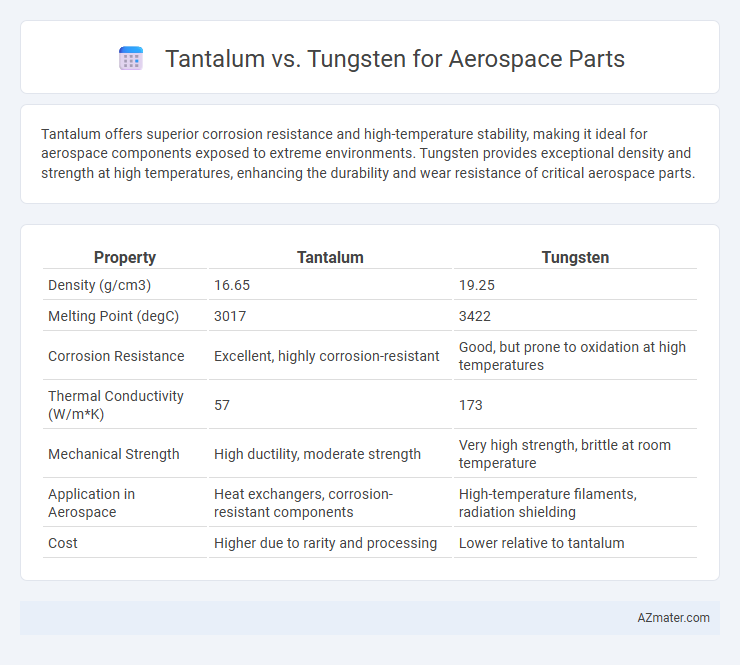Tantalum offers superior corrosion resistance and high-temperature stability, making it ideal for aerospace components exposed to extreme environments. Tungsten provides exceptional density and strength at high temperatures, enhancing the durability and wear resistance of critical aerospace parts.
Table of Comparison
| Property | Tantalum | Tungsten |
|---|---|---|
| Density (g/cm3) | 16.65 | 19.25 |
| Melting Point (degC) | 3017 | 3422 |
| Corrosion Resistance | Excellent, highly corrosion-resistant | Good, but prone to oxidation at high temperatures |
| Thermal Conductivity (W/m*K) | 57 | 173 |
| Mechanical Strength | High ductility, moderate strength | Very high strength, brittle at room temperature |
| Application in Aerospace | Heat exchangers, corrosion-resistant components | High-temperature filaments, radiation shielding |
| Cost | Higher due to rarity and processing | Lower relative to tantalum |
Introduction: Tantalum vs Tungsten in Aerospace
Tantalum and tungsten are critical materials in aerospace engineering due to their exceptional density, high melting points, and corrosion resistance. Tantalum offers superior ductility and excellent resistance to chemical attack, making it ideal for components exposed to harsh environments. Tungsten provides unmatched strength and thermal stability, essential for high-temperature aerospace parts such as turbine blades and heat shields.
Material Composition and Properties
Tantalum exhibits excellent corrosion resistance, high melting point (3017degC), and superior ductility, making it ideal for aerospace components exposed to extreme environments. Tungsten offers exceptional density (19.25 g/cm3), highest melting point (3422degC), and remarkable tensile strength, suited for structural parts requiring wear resistance and heat durability. Both metals contribute to aerospace applications, but tantalum's biocompatibility and chemical stability contrast with tungsten's unmatched hardness and thermal conductivity.
Density and Weight Considerations
Tantalum and tungsten are both high-density metals used in aerospace applications, with tantalum having a density of approximately 16.6 g/cm3 and tungsten at about 19.3 g/cm3. Tungsten's higher density contributes to greater weight, which can be a disadvantage in aerospace parts where weight reduction is critical for fuel efficiency and performance. Selecting tantalum over tungsten for aerospace components can offer a balance of density and strength, reducing overall weight while maintaining durability under extreme conditions.
Thermal Resistance and Stability
Tungsten exhibits exceptional thermal resistance with a melting point of 3422degC, making it ideal for aerospace parts exposed to extreme heat and high thermal stress. Tantalum offers superior chemical stability and maintains strength at high temperatures around 3017degC, providing excellent corrosion resistance in reactive environments. Tungsten's high density and thermal conductivity complement aerospace applications requiring efficient heat dissipation, whereas Tantalum's stability supports components prone to oxidation and thermal cycling.
Corrosion and Oxidation Resistance
Tantalum offers superior corrosion resistance in aerospace applications due to its exceptional ability to form stable oxide layers that protect against harsh environmental conditions. Tungsten exhibits high oxidation resistance at elevated temperatures but is more susceptible to oxidation at lower temperatures, which can compromise long-term durability in certain aerospace parts. Selecting tantalum over tungsten enhances lifespan and reliability for components exposed to aggressive chemical environments and oxidative stress in aerospace engineering.
Mechanical Strength and Durability
Tungsten exhibits superior mechanical strength with a tensile strength of around 1510 MPa, making it ideal for aerospace parts requiring high load-bearing capacity. Tantalum, while less strong with tensile strength near 200-300 MPa, offers exceptional corrosion resistance and durability in extreme environments, enhancing the lifespan of aerospace components. Tungsten's high melting point of 3422degC surpasses tantalum's 3017degC, contributing to better performance under high-temperature aerospace conditions.
Machinability and Fabrication Challenges
Tantalum offers superior corrosion resistance and ductility, making it suitable for aerospace components exposed to extreme environments, but its machinability is hindered by high toughness and tendency to gall during cutting. Tungsten provides exceptional hardness and high melting point, ideal for aerospace parts requiring wear resistance and thermal stability, yet its brittleness and high density create fabrication challenges, including tool wear and difficulties in precise machining. Manufacturers often balance these factors by selecting tantalum for complex, high-corrosion parts and tungsten for components requiring high strength and thermal endurance, optimizing fabrication processes accordingly.
Cost and Availability of Tantalum and Tungsten
Tantalum boasts higher cost due to its rarity and complex extraction processes, making it less economical than tungsten, which is more abundant and widely mined globally. Tungsten's greater availability supports consistent supply chains crucial for aerospace manufacturing, whereas tantalum's limited deposits often lead to supply constraints and volatility in pricing. These factors position tungsten as a more cost-effective and reliable choice for aerospace parts compared to tantalum.
Typical Aerospace Applications
Tantalum is favored in aerospace for components requiring high corrosion resistance and excellent thermal stability, such as in turbine blades and chemical processing equipment within engines. Tungsten's exceptional density and high melting point make it ideal for radiation shielding, ballast weights, and heat-resistant parts in aerospace structures. Both metals contribute to aircraft safety and performance, with tantalum used in electrical connectors and tungsten in vibration dampers and counterweights.
Conclusion: Choosing the Right Material for Aerospace Parts
Tantalum offers exceptional corrosion resistance and high ductility, making it ideal for aerospace parts exposed to extreme environments and thermal stress. Tungsten provides superior hardness and high-temperature strength, suitable for components requiring wear resistance and structural integrity under intense heat. Selecting between tantalum and tungsten depends on specific aerospace applications, balancing corrosion resistance with mechanical durability to optimize performance and longevity.

Infographic: Tantalum vs Tungsten for Aerospace Part
 azmater.com
azmater.com